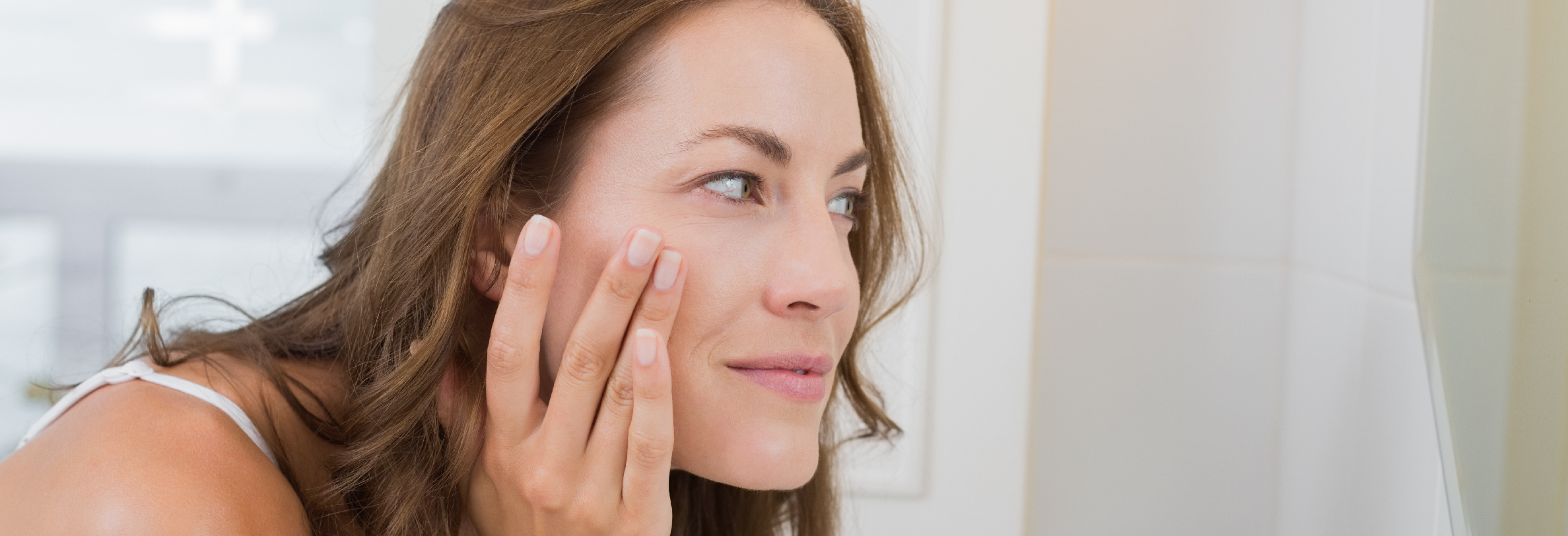If you’re looking for wrinkle prevention or treatment options, you’ve likely discovered Botox, Dysport or Xeomin. All three medications play similar roles in aesthetics, but there are crucial differences between each one.
At Derma Health, we offer several injectable products for patients; the neurotoxins Botox and Dysport as well as dermal fillers like Juvederm, Voluma, Restylane, Refyne, Sculptra and several others. Dermal fillers are distinct from neurotoxins like Botox, Dysport and Xeomin, and offer different results. You can learn more about these differences here.
How did we choose to offer Botox and Dysport? And what’s the difference between the various medications? Let’s look closer at the details to help you learn more about each product so you’ll be informed when your provider makes his/her recommendations.
What Are Neuromodulators, and How Do They Work?
Botox, Dysport and Xeomin are all neurotoxins—compounds that are very beneficial when administered by trained medical providers in small doses. When injected in these smaller doses and used to target wrinkles, they’re known as neuromodulators.
All three are also different types of botulinum toxin, which is a naturally-occurring byproduct of Clostridium botulinum bacteria. C. botulinum is found in soils, trees and other organic materials.
- Before we get into how botulinum toxin works, let’s break down a few key points:
When you emote (smile, frown, laugh or squint), your muscles contract. - These muscle contractions create dynamic lines—skin creases that fade once you stop emoting.
- While dynamic lines fade quickly, repeated contractions and creases can form static lines over time. Depending on your age, skin, hereditary and medical history, some of these lines can become quite deep over time (permanent wrinkles).
When injected into the facial muscles, botulinum toxin blocks the nerve receptors that cause muscle contractions that, in turn, create dynamic (and eventually static) lines. So, these medications can treat existing wrinkles and prevent future wrinkles from forming (for as long as treatment continues).
What Is Botox?
Botox is the commercial name for onabotulinumtoxinA, one type of botulinum toxin.
The FDA has approved OnabotulinumtoxinA to treat:
- Frown lines between the eyebrows and around the eye area
- Urination complications, including:
- Urgency
- Frequency
- Incontinence
- Muscle spasms in a variety of areas, like the:
- Elbows
- Wrists
- Fingers
- Ankles
- Toes
- Head
- Neck
- Chronic migraines
- Hyperhidrosis, or excessive sweating in the armpits, hands or feet
Botox is one of the most well-known botulinum toxin injectables on the market today.
What Is Dysport?
Dysport is the brand name of abobotulinumtoxinA, another derivative of the botulinum toxin that’s distinct from Botox (onabotulinumtoxinA).
It’s currently FDA-approved to treat the following:
- Moderate to severe glabellar lines (wrinkles between the eyebrows)
- Muscle spasms related to cervical dystonia (CD)
- Upper limb spasms in adults
- Lower limb spasms in children over the age of 2
What Is Xeomin?
Xeomin is the commercial name for incobotulinumtoxinA, a type of botulinum toxin that’s different from both abobotulinumtoxinA (Dysport) and onabotulinumtoxinA (Botox).
The FDA has approved Xeomin to treat multiple conditions in adults only, including:
- Chronic sialorrhea (excessive drooling)
- Upper limb spasms
- Cervical dystonia (CD) and its associated spasticity
- Moderate to severe glabellar lines (wrinkles between the eyebrows)
Important Differences Between Botox, Dysport and Xeomin
You may have already noticed some of the differences between Botox, Dysport and Xeomin—particularly their FDA approval for slightly varying conditions. But there are other crucial contrasting elements to consider.
The Manufacturing Process
Botox, Dysport and Xeomin are made in distinct ways:
- Botox is synthesized from botulinum toxin via the Schantz Crystallization Method—essentially, manufacturers grow C. botulinum in a culture plate, strain the liquid and add other chemical agents until pure onabotulinumtoxinA forms crystals, which can be extracted and diluted for injections.
- To make Dysport, manufacturers use a process called chromatographic purification. C. botulinum is dissolved into various solutions until pure abobotulinumtoxinA solids can be extracted from the solution.
- Xeomin is produced via lyophilization, a method that requires freezing C. botulinum and its botulinum toxin byproducts and using a vacuum to evaporate all of the liquids, leaving behind pure incobotulinumtoxinA.
Effectiveness
There are two things to note about the effectiveness of all three botulinum toxins:
- The medications aren’t interchangeable. They work in distinct ways, treat different conditions and pose unique potential side effects. So, effectiveness can only be compared for the overlapping conditions that they treat—muscle spasms and wrinkle treatment.
- Studies comparing the effectiveness of each medication are still ongoing. Right now, most complete studies have only compared Botox to Xeomin.
Current evidence suggests that Botox displays greater biological activity (i.e., impactful behavior in the body after injection) than Xeomin; studies comparing both medications to Dysport are still in progress.
Side Effects
Researchers describe the number of both side effect types and total cases as “tolerability.” If a medication is tolerable, it doesn’t produce many side effects.
Current data—including information from the World Health Organization—indicates that Botox is the most tolerable among all three medications. Botox offers both fewer types of side effects and fewer cases of side effects.
Researchers aren’t sure why this is the case yet, but all medication studies emphasize safety. Plus, if a medication has achieved FDA approval—like Botox, Dysport and Xeomin all have—it’s been proven to be both safe and effective for its intended use.
Dosages
Another reason why Botox, Dysport and Xeomin aren’t interchangeable is that their dosages are different:
- The FDA-approved maximum doses for Botox include:
- 20 units for forehead lines
- 20 units for glabellar lines (wrinkles between the eyebrows)
- 24 units for lateral canthal lines (“crow’s feet”)
- The FDA has only approved Dysport for the treatment of glabellar lines, and has approved doses of 50 units split evenly between five equal injections in the facial muscles that are causing wrinkling.
- Xeomin is FDA-approved for 20 units divided into five equal injections:
- Two injections should be applied to both corrugator muscles
- One injection should be applied to the procerus muscle
When it comes to dosages, it’s necessary to note that your provider will determine which neurotoxin and which dose is best to address your specific concerns. If you are seeing a provider for the first time, we always recommend scheduling a follow-up appointment two weeks after you receive your injections, so we can make any final adjustments and fine-tune your treatment.
Which Is Right for Me—Botox, Dysport or Xeomin?
The differences between Botox, Dysport and Xeomin are complicated, and after reviewing your past results or medical history your provider may determine that one is better suited for your treatment over another. He/she can help you decide which medication is right for you depending on:
- The areas of your face that you’d like to treat
- Your tolerance to each specific medication
- The non-aesthetic health conditions you’re trying to alleviate
- Your budget
The most important thing to remember is that, if you’re not getting the results you want from your chosen medication, you can stop treatment at any time.
If you’re looking for a medspa with experienced experts who can help you take the next step on your aesthetic journey, you’re in the right place.
At Derma Health, we’re committed to using only the best and most effective treatments on the market, like Botox. We are the #1 Ranked Botox provider in the Southwest and our Injectors are highly skilled and trained in administering both on label and off label Botox injections. Throughout our 17+ years in the industry, we’ve seen this treatment work wonders for patients trying to treat and prevent facial wrinkles.
If you’re ready to look and feel your best, book an appointment online today. We can’t wait to help you take the next step in your wellness journey!
Sources:
American Board of Cosmetic Surgery. Botox-Type Injectables Guide. https://www.americanboardcosmeticsurgery.org/procedure-learning-center/non-surgical/guide-botox-type-injectables/
Medline Plus. Botox. https://medlineplus.gov/botox.html
American Society of Plastic Surgeons. Botulinum Toxin. https://www.plasticsurgery.org/cosmetic-procedures/botulinum-toxin
US Food and Drug Administration. Medication Guide – Botox. https://www.fda.gov/media/77359/download
US Food and Drug Administration. Highlights of Prescribing Information – DYSPORT. https://www.accessdata.fda.gov/drugsatfda_docs/label/2016/125274s107lbl.pdf
US Food and Drug Administration. Highlights of Prescribing Information – XEOMIN. https://www.accessdata.fda.gov/drugsatfda_docs/label/2018/125360s073lbl.pdf
Functional Neurology. Pharmacological differences and clinical implications of various botulinum toxin preparations: a critical appraisal. https://www.ncbi.nlm.nih.gov/pmc/articles/PMC5901944/
Microbiological Reviews. Properties and Use of Botulinum Toxin and Other Microbial Neurotoxins in Medicine. https://www.ncbi.nlm.nih.gov/pmc/articles/PMC372855/pdf/microrev00028-0098.pdf
US Food and Drug Administration. The FDA’s Drug Review Process: Ensuring Drugs Are Safe and Effective. https://www.fda.gov/drugs/information-consumers-and-patients-drugs/fdas-drug-review-process-ensuring-drugs-are-safe-and-effective
Botox Cosmetic. Dosage & Administration. https://hcp.botoxcosmetic.com/product-information/dosage



